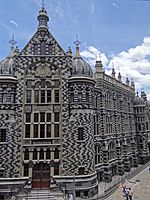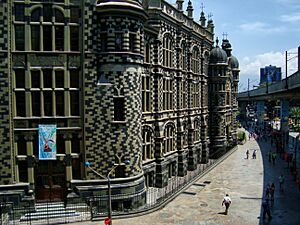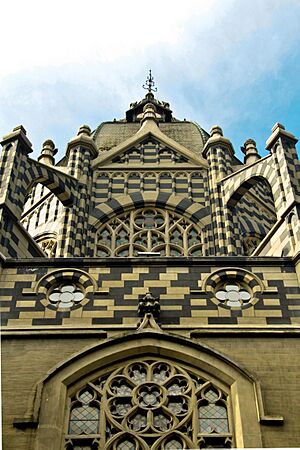Rafael Uribe Uribe Palace of Culture facts for kids
Quick facts for kids Rafael Uribe Uribe Palace of Culture |
|
|---|---|
|
Palacio de la Cultura Rafael Uribe Uribe
|
|
 |
|
| General information | |
| Architectural style | Gothic Revival |
| Location | Medellín, Colombia |
| Address | 51st Avenue #52-03 |
| Construction started | 1925 |
| Design and construction | |
| Architect | Agustín Goovaerts |
The Rafael Uribe Uribe Palace of Culture is a beautiful public building in Medellín, Colombia. It's a place where people can enjoy many cultural activities. You can find concerts, talks, and art shows here. A Belgian architect named Agustín Goovaerts designed it. He used a style called Gothic Revival, which looks like old European castles. The palace is named after Rafael Uribe Uribe, who was an important general in Colombia.
This palace is a special place in Colombia. It's known as a national monument. This means it's an important historical building. Everyone can visit it for free! Inside, you'll find the Institute of Culture and Heritage of Antioquia. This institute helps keep the local culture alive. Visitors can explore old photos, listen to music, read books in the library, and see amazing art. There's even a museum room dedicated to Rafael Uribe Uribe. The building also has a large dome that works as an auditorium. You can watch movies or attend events there.
Contents
Where is the Palace?
The Palace of Culture is in the La Candelaria area of Medellín. This is a busy part of the city. Many people walk around here every day. It's close to several other famous spots. You can find the Medellín Metro's Berrío Park station nearby. Also close are Botero Plaza, Berrío Park, the Museum of Antioquia, Bolívar Park, and the Basilica of Our Lady of Candelaria. It's a great central location for exploring Medellín!
How the Palace Began
In 1826, the main government office for the Antioquia region moved to Medellín. People soon realized they needed a proper building for the government. The first office was just an old house with a few rooms.
Years later, in 1920, General Pedro Nel Ospina became the Governor of Antioquia. He later became the President of Colombia. He asked for new buildings to be constructed in Medellín, including this palace. The first plans for the building were very grand. But they had to make it a bit smaller than planned. The Rafael Uribe Uribe Palace was first called "Calibío Palace." It was the main government building for Antioquia. Construction started in 1925 and finished in 1937.
Building the Palace
First Steps of Construction
Building work started in 1925. The first part built was at the corner of Calibío Street and Bolívar Street. This section was meant to hold government records and the local assembly. However, work had to stop in 1929. This was because of a money problem during a big economic crisis. The government didn't have enough funds. This delay lasted for four years.
The Second Phase
After four years, building started again in 1932. This time, they built the octagonal part and the East Wing. They also built the stairs, hallways, and balconies facing Bolívar Street. An engineer named Jesús Mejía changed some plans for the balcony area. This was because the space would be used differently.
Inside, the Assembly Hall was decorated beautifully. It's now called the Luis Lopez Auditorium Bureau. You can see bronze art made by Bernardo Vieco. There's also a large painting called "The Liberation of Slaves" by Ignacio Gómez Jaramillo. The palace has amazing stained glass windows. These were made using an old technique with lead by the Horace and Arturo Longas brothers. A grand central lamp also hangs inside.
The Final Stage
In 1937, the government stopped using the palace. The unfinished parts were closed off with temporary fences. Because of this, the government decided to build a new main office somewhere else.
Later, architects Gerardo Mejía, Gustavo Restrepo, and Gustavo Aristizabal were hired to finish the palace. They worked on the north side of the building. They also brought back some of the original decorations. Finally, in 1982, the palace was officially named a national monument. This means it's a very important historical site.
A New Name for the Palace
The government offices moved to a new building called La Alpujarra Administrative Center. Since the "Calibío Palace" was no longer the government's main office, it got a new name in 1987. It was renamed the "Rafael Uribe Uribe Palace of Culture." This was to honor the Colombian general Rafael Uribe Uribe. He was a hero who fought in the Thousand Days War.
Some people thought the palace should become a shopping center. This had happened to other old buildings in Medellín. Others even suggested tearing it down to build something new. But thankfully, the palace was saved! In 1986 and 1988, special rules were made. These rules said the palace should be used for cultural activities. So, it became the home of the Institute for Culture and Heritage of Antioquia.
Palace Design
The first plans for the palace were very ambitious. They included five floors with over 300 offices. There was also a plan for a huge hall, a library, and a museum. Not all of these ideas were built. The palace now has four floors. It also has a central courtyard and a rooftop area where you can look out over the city.
The dome of the palace is a true marvel of engineering. Its metal supports came all the way from Belgium in 1928. They were put together using a method like the one used for skyscrapers in New York. Workers would heat the nuts and bolts until they glowed red. This made them tighten very strongly as they cooled. This method made the structure very strong, even without welding.
Images for kids
-
The palace lit up during Christmas time.
-
A statue of Colombian writer Tomás Carrasquilla.
See also
 In Spanish: Palacio de la Cultura Rafael Uribe Uribe para niños
In Spanish: Palacio de la Cultura Rafael Uribe Uribe para niños









